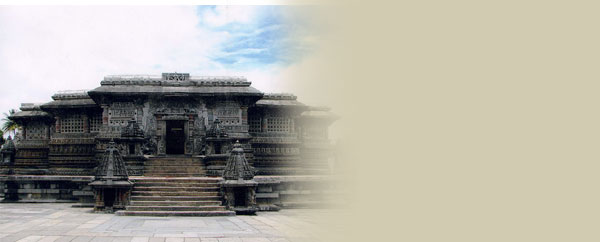Chennakesava Temple (Karnataka)
The Hoysalas employed many noted architects
and artisans who developed a new architectural
tradition, which some historians call Karnata
Dravida tradition.
Chennakesava Temple (Karnataka) Hindu Temples

Chennakesava Temple originally called Vijayanarayana Temple was built on the banks of the Yagachi River in Belur, an early capital of the Hoysala Empire. Belur is 40 km from Hassan city and 220 km from Bangalore, in Hassan district of Karnataka state, India. Chennakesava literally means "handsome Kesava" and is a form of Hindu God Vishnu. Belur is well-known for its marvelous temples, built during the rule of Hoysala dynasty, makig it and nearby Halebidu, a favored tourist destination in Karnataka.
History
The temple was commissioned by Hoysala King Vishnuvardhana in 1117 CE. Scholars are divided about the reason why King Vishnuvardhana commissioned the construction of the temple. The military successes of Vishnuvardhana is considered a probable reason. Some scholars believe Vishnuvardhana commissioned the temple to surpass his overlords, the Western Chalukya Empire (who ruled from Basavakalyan), after his military victories against them. According to another theory, Vishnuvardhana was celebrating his victory against the Cholas of Tamil country in the battle of Talakad, which resulted in the annexation of Gangavadi (modern southern Karnataka) by the Hoysalas. Another explanation points to Vishnuvardhana's conversion from Jainism to Vaishnavism, considering this is predominantly a Vaishnava temple.
The Hoysalas employed many noted architects and artisans who developed a new architectural tradition, which some historians call Karnata Dravida tradition. A total of 118 inscriptions have been recovered from the temple complex, covering the period between c. 1117 CE to 18th century, which give details of the artists employed, grants made to the temple and renovations.
Artists
The Hoysala artists, unlike other medieval artists, preferred to sign their work in the form of inscriptions. In doing so, they sometimes revealed fascinating details about themselves, their families, guilds and place of origin. Stone inscriptions and copper plate inscriptions provide more information about them. Ruvari Mallitamma was a prolific artist to whom more than 40 sculptures are attributed.
Dasoja and his son Chavana who were from Balligavi in modern Shimoga district made important contributions. Chavana is credited with the work on five madanikas and Dasoja with four. Malliyanna and Nagoja created birds and animals in their sculptures. Artists such as Chikkahampa and Malloja are credited with some of the sculptures in the mantapa.
Other links
Hindu Temples in India
temples
Karnataka